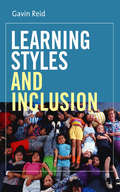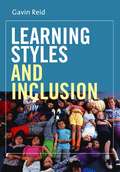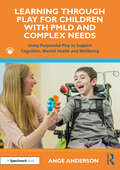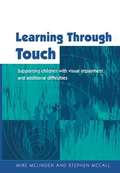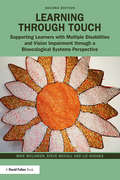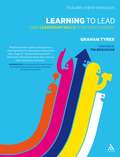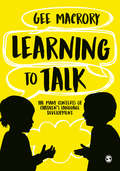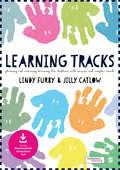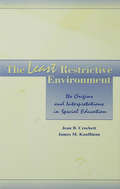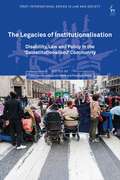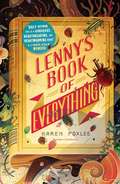- Table View
- List View
Learning Styles and Inclusion
by Gavin Reid'[Gavin Reid] provides some useful links to websites devoted to different approaches. Some of the ideas relating to specific areas of the curriculum, for example, the suggested approaches to the teaching of modern languages, are likely to be particularly valuable. Reid also outlines strategies using learning styles for pupils with learning differences, including attention disorders, dyslexia, developmental co-ordination difficulties, number difficulties, and those on the autistic spectrum' - Times Educational Supplement Extra for Special Needs `We have been lucky enough to hear Gavin speak twice in the last year and those of you who have also heard him will know that he is at the cutting edge of his field. This book really encompasses those areas that are particularly topical and the "buzz" words on everyone's lips! This book clearly sets out "who" is involved in inclusion and "what" is actually meant by learning styles. Gavin not only offers practical strategies but also suggests how "old hands" could vary their teaching styles to appeal to all types of learners. Therefore we feel this book is for the main stream teacher as well as the specialist and, if this is a target area for your school, this book might be a valuable addition to your bookshelf' - SATIPS `In this book, Gavin Reid has grasped the nettle (of inclusion) with both hands and provided a text that is full of common sense and practical suggestions as to how the mainstream teacher can draw upon recent psychological theory and research to enhance the learning of all children. He jumps on no bandwagons but draws judiciously from a wide range of approaches to assessing learning styles and links what can be learned about groups and individuals from such techniques to helpful classroom practice' - Professor Bob Burden, School of Education and Lifelong Learning, University of Exeter `Gavin Reid is that rare professional who not only explains how and why children learn best, but also suggests a myriad of practical strategies to help them. I highly recommend this book for everyone from undergraduates to "old hands" working toward successful inclusion. Parents, too, will profit from Dr. Reid's wise and comprehensive experience' - Jane M. Healy, Ph.D., Educational Psychologist and Author of "Your Child's Growing Mind: Brain Development and Learning from Birth to Adolescence." 3rd Edition. NY: Broadway Books, 2004. Drawing on his considerable experience as a teacher, educational psychologist, lecturer and author, Gavin Reid illustrates how to assess pupils' different learning styles and how to vary your teaching style to appeal to all types of learners, including disaffected students and those with special educational needs. This book provides an overview of the different stages in the learning cycle; describes the differences between learners; and emphasizes the role the classroom environment and different teaching styles play in children's ability to learn. Readers will see how an understanding of learning styles can be used to encourage and promote good inclusive practice. Ideas for assessment of learning styles and examples of different teaching styles will prove invaluable to class teachers, trainee teachers, SENCOs, LEA advisers; NQTs and NQT advisers and school management
Learning Styles and Inclusion (PDF)
by Gavin Reid'[Gavin Reid] provides some useful links to websites devoted to different approaches. Some of the ideas relating to specific areas of the curriculum, for example, the suggested approaches to the teaching of modern languages, are likely to be particularly valuable. Reid also outlines strategies using learning styles for pupils with learning differences, including attention disorders, dyslexia, developmental co-ordination difficulties, number difficulties, and those on the autistic spectrum' - Times Educational Supplement Extra for Special Needs `We have been lucky enough to hear Gavin speak twice in the last year and those of you who have also heard him will know that he is at the cutting edge of his field. This book really encompasses those areas that are particularly topical and the "buzz" words on everyone's lips! This book clearly sets out "who" is involved in inclusion and "what" is actually meant by learning styles. Gavin not only offers practical strategies but also suggests how "old hands" could vary their teaching styles to appeal to all types of learners. Therefore we feel this book is for the main stream teacher as well as the specialist and, if this is a target area for your school, this book might be a valuable addition to your bookshelf' - SATIPS `In this book, Gavin Reid has grasped the nettle (of inclusion) with both hands and provided a text that is full of common sense and practical suggestions as to how the mainstream teacher can draw upon recent psychological theory and research to enhance the learning of all children. He jumps on no bandwagons but draws judiciously from a wide range of approaches to assessing learning styles and links what can be learned about groups and individuals from such techniques to helpful classroom practice' - Professor Bob Burden, School of Education and Lifelong Learning, University of Exeter `Gavin Reid is that rare professional who not only explains how and why children learn best, but also suggests a myriad of practical strategies to help them. I highly recommend this book for everyone from undergraduates to "old hands" working toward successful inclusion. Parents, too, will profit from Dr. Reid's wise and comprehensive experience' - Jane M. Healy, Ph.D., Educational Psychologist and Author of "Your Child's Growing Mind: Brain Development and Learning from Birth to Adolescence." 3rd Edition. NY: Broadway Books, 2004. Drawing on his considerable experience as a teacher, educational psychologist, lecturer and author, Gavin Reid illustrates how to assess pupils' different learning styles and how to vary your teaching style to appeal to all types of learners, including disaffected students and those with special educational needs. This book provides an overview of the different stages in the learning cycle; describes the differences between learners; and emphasizes the role the classroom environment and different teaching styles play in children's ability to learn. Readers will see how an understanding of learning styles can be used to encourage and promote good inclusive practice. Ideas for assessment of learning styles and examples of different teaching styles will prove invaluable to class teachers, trainee teachers, SENCOs, LEA advisers; NQTs and NQT advisers and school management
Learning Through Play for Children with PMLD and Complex Needs: Using Purposeful Play to Support Cognition, Mental Health and Wellbeing
by Ange AndersonThis book examines the development of play skills and schemas to support children with learning differences and physical disabilities in learning to play. It highlights the need for appropriate playground equipment in all school settings that educate children with physical disabilities and sensory needs to ensure equal opportunities for outdoor play. Several play approaches for meeting sensory needs are discussed including Lego therapy, Art therapy, Sand play and Soft play. Digital play for students with physical disabilities is an important chapter in the book. Role play and the ways in which virtual reality and psychodrama support anxieties that some students have is another important chapter. There is also a chapter devoted to parents on how they can support their child at home and how the school can support them. At the end of the book there is a plethora of resources that readers can copy or adapt to suit their setting. The book provides support for those managing outdoor play for these children at peak times of the day. It shows how play-based learning can work in a classroom setting; the importance of sensory profiles and sensory play; and how play therapy can aid neuroplasticity.
Learning Through Play for Children with PMLD and Complex Needs: Using Purposeful Play to Support Cognition, Mental Health and Wellbeing
by Ange AndersonThis book examines the development of play skills and schemas to support children with learning differences and physical disabilities in learning to play. It highlights the need for appropriate playground equipment in all school settings that educate children with physical disabilities and sensory needs to ensure equal opportunities for outdoor play. Several play approaches for meeting sensory needs are discussed including Lego therapy, Art therapy, Sand play and Soft play. Digital play for students with physical disabilities is an important chapter in the book. Role play and the ways in which virtual reality and psychodrama support anxieties that some students have is another important chapter. There is also a chapter devoted to parents on how they can support their child at home and how the school can support them. At the end of the book there is a plethora of resources that readers can copy or adapt to suit their setting. The book provides support for those managing outdoor play for these children at peak times of the day. It shows how play-based learning can work in a classroom setting; the importance of sensory profiles and sensory play; and how play therapy can aid neuroplasticity.
Learning Through Talk in the Early Years: Practical Activities for the Classroom (PDF)
by Liz Sharp`This book is aimed at class teachers of Reception to Year 3 seeking ideas to develop their pupils' speaking and listening skills. The author describes each activity in an easy-to-follow format with links to the relevant curriculum targets. The most valuable part of the book is the commentary from the author's own teaching experience. This provides some useful insights, such as the fact that the flow of children's ideas was improved while they had a discussion while engaged in drawing. The book is easy to read. It… provide[s] a practical guide to some tried and tested speaking and listening activities which may be useful for the beginning Foundation or Key Stage 1 teacher' - Special! Do the children in your class need help with language and listening skills? Lots of ideas and suggestions for activities using and encouraging talk in the classroom make this book a lively, practical guide to encouraging young children to develop their verbal reasoning skills and to communicate more effectively. There is advice on how to tie in these activities with the various curriculum subjects and the following are covered: - setting up a talk corner - using story bags and story boxes - using Circle Time and playing games to encourage talk In each activity there are directions for helping children with Special Educational Needs, working with Teaching Assistants (TAs) and other adults in the classroom, planning and assessing work and finding suitable resources. A selection of photocopiable material is included and all the suggestions and ideas in the book have been tried and tested by the author in her own classroom. The focus of this book is on young children aged 5 to 8, but the activities can be adapted to suit those younger or older.
Learning Through Touch: Supporting Children With Visual Impairment and Additional Difficulties (PDF)
by Mike Mclinden Steve MccallWritten to assist teachers and other professionals who support children with visual impairment and additional difficulties, this text examines the role of touch in developing effective teaching and learni. The book is divided into eleven chapters that provide useful background information about the sense of touch, and consider how potential barriers to independent learning through touch can be reduced through structuring appropriate learning experiences. A series of reflective activities are included which are designed to draw out key issues from relevant chapters and invite the reader to explore the implications for his or her practice. A number of these activities are designed to cross-reference with relevant extension standards from the National SEN Specialist Standards for teachers and recommendations about further reading and teaching resources are provided throughout the book. This text will be useful for teachers and learning support staff working with children who have visual impairment and additional difficulties. It will also have relevance to other professionals working with children with severe and complex needs who wish to understand more about the role of touch in developing effective learning. experiences.
Learning through Touch: Supporting Learners with Multiple Disabilities and Vision Impairment through a Bioecological Systems Perspective
by Mike Mclinden Steve Mccall Liz HodgesThis fully revised and updated second edition of Learning through Touch is essential reading for practitioners who support learners with multiple disabilities and vision impairment. These learners will rely on support from their learning partners throughout their education to mediate their learning experiences. The text explores the key role that touch plays in the education of these learners and provides practical advice about how to develop the skills through touch that they will need to become ‘active agents’ in their own development. The book reflects international initiatives that seek to ensure that people with disabilities have opportunities to take meaningful control within their learning and their lives. Key features include: Chapters that support curriculum access for learners with visual impairments; Reflections on up-to-date research studies and guidance for further reading throughout, allowing for a strong conceptual foundation for practice; Portfolio activities designed to help implement effective learning opportunities within your own practice. Written to assist teachers and other professionals who support children with visual impairment and additional difficulties, this text will appeal to professionals and students alike. It is an invaluable resource for anyone looking to explore the role of touch in creating effective learning experiences.
Learning through Touch: Supporting Learners with Multiple Disabilities and Vision Impairment through a Bioecological Systems Perspective
by Mike Mclinden Steve Mccall Liz HodgesThis fully revised and updated second edition of Learning through Touch is essential reading for practitioners who support learners with multiple disabilities and vision impairment. These learners will rely on support from their learning partners throughout their education to mediate their learning experiences. The text explores the key role that touch plays in the education of these learners and provides practical advice about how to develop the skills through touch that they will need to become ‘active agents’ in their own development. The book reflects international initiatives that seek to ensure that people with disabilities have opportunities to take meaningful control within their learning and their lives. Key features include: Chapters that support curriculum access for learners with visual impairments; Reflections on up-to-date research studies and guidance for further reading throughout, allowing for a strong conceptual foundation for practice; Portfolio activities designed to help implement effective learning opportunities within your own practice. Written to assist teachers and other professionals who support children with visual impairment and additional difficulties, this text will appeal to professionals and students alike. It is an invaluable resource for anyone looking to explore the role of touch in creating effective learning experiences.
Learning to Become Socially Talented Children
by Karen Palmer-Roach Rebecca ChildsThis resource includes more than 70 worksheets to make social and emotional learning fun! This resource uses exciting graphics, games and activities to engage and stimulate children in the learning process. It deals with a wide range of issues that affect children today.
Learning to Become Socially Talented Children
by Karen Palmer-Roach Rebecca ChildsThis resource includes more than 70 worksheets to make social and emotional learning fun! This resource uses exciting graphics, games and activities to engage and stimulate children in the learning process. It deals with a wide range of issues that affect children today.
Learning to Lead: Using Leadership Skills to Motivate Students
by Graham TyrerStudents want to be trusted and challenged, even when it looks like they don't! Leadership gives them a sense that they have something to offer, and that their experiences can be useful and helpful to others. Even the most disruptive, difficult student is showing leadership qualities - it's just not in the right direction, yet. This book contains 50 activities for building confidence and skills in students for leading themselves, others and their communities. It also includes online resources detailing a plan on 10 workshops incorporating and adapting the activities in the book to fit a mix of learning styles. Incorporating leadership learning into the curriculum in both primary and secondary schools will challenge students to take responsibility for themselves and others, build their self-esteem and improve the lives of others in the school and local community. Incorporating leadership learning into the curriculum in both primary and secondary schools, will challenge students to take responsibility for themselves and others, build their self-esteem and improve the lives of others in the school and local community.
Learning to Talk: The many contexts of children’s language development
by Gee MacroryThere is a pressing need for new teachers to understand the wider context of language development and to know how best to support children in learning to talk. This accessible text introduces you to the numerous contexts of language development. It helps you understand the many ways in which children acquire language skills. Importantly, it provides a breadth of learning about language not offered by other texts exploring typical language development, atypical language development and learning more than one language. The book also explores the current literature and research on language development for primary aged children, supporting trainee teachers with their academic study.
Learning to Talk: The many contexts of children’s language development
by Gee MacroryThere is a pressing need for new teachers to understand the wider context of language development and to know how best to support children in learning to talk. This accessible text introduces you to the numerous contexts of language development. It helps you understand the many ways in which children acquire language skills. Importantly, it provides a breadth of learning about language not offered by other texts exploring typical language development, atypical language development and learning more than one language. The book also explores the current literature and research on language development for primary aged children, supporting trainee teachers with their academic study.
Learning to Talk: The many contexts of children’s language development
by Gee MacroryThere is a pressing need for new teachers to understand the wider context of language development and to know how best to support children in learning to talk. This accessible text introduces you to the numerous contexts of language development. It helps you understand the many ways in which children acquire language skills. Importantly, it provides a breadth of learning about language not offered by other texts exploring typical language development, atypical language development and learning more than one language. The book also explores the current literature and research on language development for primary aged children, supporting trainee teachers with their academic study.
Learning to Teach Inclusively: Student Teachers' Classroom Inquiries
by Celia OylerThis book—co-authored by a teacher educator, a diverse group of five pre-service student teachers, and their student teaching supervisor—takes a unique, illuminating look at the experience of student teaching from the perspective of student teachers. It is premised on learning to teach as an inquiry process enriched by collaborative conversations. Readers are invited into student teachers’ dilemmas and decisions as they negotiate between their public school placements and their university-based coursework. Throughout the year of student teaching, the authors document their discussions and reflections about teaching in inclusive classrooms that shed light on the complex process of learning to teach and also offer insights into issues of teaching for equity. Each of the central chapters is written by an individual student teacher and tracks a specific question over the course of two semesters. Topics include: *contrasting models of inclusion and teachers’ differing orientations toward issues of community, difference, and normalcy;*how teachers foster peer relationships;*classroom management and discipline; *heterogeneous instruction; and*school-wide culture and systems that promote or mitigate against inclusion. A new perspective on what can be learned from student teaching is provided by the student teachers’ supervisor. In the concluding chapter, the teacher educators address the connections among the student teachers’ inquiries and offer an analysis from a disability studies/disability rights perspective on how inclusion fits into a social (rather than a medical) model of disability. All of the authors of this book seek to contribute to conversations that place advocacy, inquiry, contestation, and challenge at the center of the teacher’s role. This volume is their invitation to readers to join in a larger conversation about the challenges of, and necessity for, becoming inclusive teachers. Learning to Teach Inclusively is intended for inservice and preservice courses in elementary education, inclusion, and teacher research, and for field experience seminars. It is also suitable for graduate courses in teacher research, supervision, and research in teacher education.
Learning to Teach Inclusively: Student Teachers' Classroom Inquiries
by Celia OylerThis book—co-authored by a teacher educator, a diverse group of five pre-service student teachers, and their student teaching supervisor—takes a unique, illuminating look at the experience of student teaching from the perspective of student teachers. It is premised on learning to teach as an inquiry process enriched by collaborative conversations. Readers are invited into student teachers’ dilemmas and decisions as they negotiate between their public school placements and their university-based coursework. Throughout the year of student teaching, the authors document their discussions and reflections about teaching in inclusive classrooms that shed light on the complex process of learning to teach and also offer insights into issues of teaching for equity. Each of the central chapters is written by an individual student teacher and tracks a specific question over the course of two semesters. Topics include: *contrasting models of inclusion and teachers’ differing orientations toward issues of community, difference, and normalcy;*how teachers foster peer relationships;*classroom management and discipline; *heterogeneous instruction; and*school-wide culture and systems that promote or mitigate against inclusion. A new perspective on what can be learned from student teaching is provided by the student teachers’ supervisor. In the concluding chapter, the teacher educators address the connections among the student teachers’ inquiries and offer an analysis from a disability studies/disability rights perspective on how inclusion fits into a social (rather than a medical) model of disability. All of the authors of this book seek to contribute to conversations that place advocacy, inquiry, contestation, and challenge at the center of the teacher’s role. This volume is their invitation to readers to join in a larger conversation about the challenges of, and necessity for, becoming inclusive teachers. Learning to Teach Inclusively is intended for inservice and preservice courses in elementary education, inclusion, and teacher research, and for field experience seminars. It is also suitable for graduate courses in teacher research, supervision, and research in teacher education.
Learning Tracks: Planning and Assessing Learning for Children with Severe and Complex Needs
by Lindy Furby Jilly CatlowLearning Tracks is an assessment tool to support the planning and assessment of learning for children and young people with severe and complex learning disabilities (SCLD). It was designed by Lindy Furby and Jilly Catlow while teaching at St Crispin’s School for children and young people with severe and complex learning disabilities. At the very early stages of learning, the steps that children and young people make can be small but incredibly significant for them and those who teach them. However, it can be problematic to evidence and formally recognise these achievements and plan next steps. Learning Tracks presents a framework to recognise achievement at these early levels and plan for progression through challenge, breadth and application. The Learning Tracks framework for recognising achievement at very early levels of learning: Can help teachers understand the way their children may be learning Offers a vocabulary for describing the learning Offers a structure for planning the learning When you purchase Learning Tracks, you receive the book that introduces you to the framework and theories underpinning Learning Tracks, describes the curriculum included and demonstrates how it can be implemented in your setting. In addition to this book you will also receive access to the complete ready-made Learning Tracks assessment tool that can be downloaded online. This is available as a PDF with editable elements and a template you can personalise it to suit your individual needs.
Learning Tracks: Planning and Assessing Learning for Children with Severe and Complex Needs
by Lindy Furby Jilly CatlowLearning Tracks is an assessment tool to support the planning and assessment of learning for children and young people with severe and complex learning disabilities (SCLD). It was designed by Lindy Furby and Jilly Catlow while teaching at St Crispin’s School for children and young people with severe and complex learning disabilities. At the very early stages of learning, the steps that children and young people make can be small but incredibly significant for them and those who teach them. However, it can be problematic to evidence and formally recognise these achievements and plan next steps. Learning Tracks presents a framework to recognise achievement at these early levels and plan for progression through challenge, breadth and application. The Learning Tracks framework for recognising achievement at very early levels of learning: Can help teachers understand the way their children may be learning Offers a vocabulary for describing the learning Offers a structure for planning the learning When you purchase Learning Tracks, you receive the book that introduces you to the framework and theories underpinning Learning Tracks, describes the curriculum included and demonstrates how it can be implemented in your setting. In addition to this book you will also receive access to the complete ready-made Learning Tracks assessment tool that can be downloaded online. This is available as a PDF with editable elements and a template you can personalise it to suit your individual needs.
The Least Restrictive Environment: Its Origins and interpretations in Special Education (The LEA Series on Special Education and Disability)
by Jean B. Crockett James M. KauffmanThe Least Restrictive Environment: Its Origins and Interpretations in Special Education examines issues of ethical leadership and clarifies instructional placement decisions that provide a full educational opportunity for students with disabilities.
The Least Restrictive Environment: Its Origins and interpretations in Special Education (The LEA Series on Special Education and Disability)
by Jean B. Crockett James M. KauffmanThe Least Restrictive Environment: Its Origins and Interpretations in Special Education examines issues of ethical leadership and clarifies instructional placement decisions that provide a full educational opportunity for students with disabilities.
Leg
by Greg MarshallGreg Marshall's early years were pretty bizarre. Rewind the VHS tapes (this is the nineties) and you'll see a lopsided teenager limping across a high school stage, or in a wheelchair after leg surgeries, pondering why he's crushing on half of the Utah Jazz. Add to this home video footage a mom clacking away at her newspaper column between chemos, a dad with ALS, and a cast of foulmouthed siblings. Fast forward the tape and you'll find Marshall happily settled into his life as a gay man only to discover he's been living in another closet his whole life: he has cerebral palsy. Here, in the hot mess of it all, lies Greg Marshall's wellspring of wit and wisdom.Leg is an extraordinarily funny and insightful memoir from a daring new voice. Packed with outrageous stories of a singular childhood, it is also a unique examination of what it means to transform when there are parts of yourself you can't change, a moving portrait of a family in crisis, and a tale of resilience of spirit. In Marshall's deft hands, we see a story both personal and universal-of being young and wanting the world, even when the world doesn't feel like yours to want.
The Legacies of Institutionalisation: Disability, Law and Policy in the ‘Deinstitutionalised’ Community (Oñati International Series in Law and Society)
by Claire Spivakovsky Linda Steele Penelope WellerThis is the first collection to examine the legal dynamics of deinstitutionalisation. It considers the extent to which some contemporary laws, policies and practices affecting people with disabilities are moving towards the promised end point of enhanced social and political participation in the community, while others may instead reinstate, continue or legitimate historical practices associated with this population's institutionalisation. Bringing together 20 contributors from the UK, Canada, Australia, Spain and Indonesia, the book speaks to overarching themes of segregation and inequality, interlocking forms of oppression and rights-based advancements in law, policy and practice. Ultimately this collection brings forth the possibilities, limits and contradictions in the roles of law and policy in processes of institutionalisation and deinstitutionalisation, and directs us towards a more nuanced and sustained scholarly and political engagement with these issues.
The Legacies of Institutionalisation: Disability, Law and Policy in the ‘Deinstitutionalised’ Community (Oñati International Series in Law and Society)
This is the first collection to examine the legal dynamics of deinstitutionalisation. It considers the extent to which some contemporary laws, policies and practices affecting people with disabilities are moving towards the promised end point of enhanced social and political participation in the community, while others may instead reinstate, continue or legitimate historical practices associated with this population's institutionalisation. Bringing together 20 contributors from the UK, Canada, Australia, Spain and Indonesia, the book speaks to overarching themes of segregation and inequality, interlocking forms of oppression and rights-based advancements in law, policy and practice. Ultimately this collection brings forth the possibilities, limits and contradictions in the roles of law and policy in processes of institutionalisation and deinstitutionalisation, and directs us towards a more nuanced and sustained scholarly and political engagement with these issues.
The Legal Rights Of Students With Disabilities: International Perspectives
by Charles J. Russo Bronagh Byrne Greg M. Dickinson Kate Diesfeld Petra Engelbrecht John Hancock Neville Harris Jim Jackson Laura Lundy Allan G. Osborne Nina Ranieri Marius Smit M. K. Teh Fatt Hee Tie Sally Varnham Ran ZhangLenny's Book of Everything
by Karen FoxleeA moving novel about love, loss and growing up with a brother who has gigantism"Tough, tender and beautiful"Glenda Millard, author of The Stars at Oktober BendLenny Spink is the sister of a giant. Her little brother Davey won't stop growing - and at seven is as tall as a man.When they receive their monthly instalment of Burrell's Build-It-at-Home Encyclopedia set, fun and excitement burst into Lenny and Davey's lives. The amazing, mysterious entries in the book's pages give them a way to dream of escape: Lenny vows to become a beetle expert, while Davey decides he will run away to Canada and build a log cabin. But as Davey's disease progresses, the siblings' richly imagined world becomes harder to cling to in this deeply moving and original novel about grief, family and wonder."Warm, humorous, absolutely real and above all, uplifting... Karen Foxlee, you're a genius" Wendy Orr, author of Dragonfly SongKaren Foxlee was born in Mount Isa, Australia. She trained and worked as a nurse before studying for a degree in creative writing at the University of the Sunshine Coast. She is the author of five books, including The Anatomy of Wings, which won the Commonwealth Writer's Prize for Best First Book in the South East Asia and South Pacific region, and Lenny's Book of Everything, which is published by Pushkin Children's Books.
